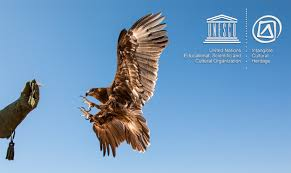Now Reading: Why Falconry Heritage Is Making a Stunning Global Comeback Today 2025
-
01
Why Falconry Heritage Is Making a Stunning Global Comeback Today 2025
Why Falconry Heritage Is Making a Stunning Global Comeback Today 2025

Table of Contents
For thousands of years, the skies have witnessed a remarkable partnership between humans and birds of prey. This rare and beautiful relationship, known as falconry, is more than a sport — it is a living heritage that connects people to nature, culture, and ancient traditions. Today, falconry heritage is not only alive but thriving, with passionate communities across the world keeping this ancient art soaring high.
What is Falconry? A Glimpse Into the Ancient Art

Falconry is the practice of training birds of prey — such as falcons, hawks, and eagles — to hunt small animals or birds in their natural habitat. This tradition dates back over 4,000 years, with its earliest roots in regions like Mongolia, the Middle East, and Persia. Over time, falconry spread across Europe, Asia, and Africa, becoming both a royal sport and a survival skill for nomads and hunters.
In medieval Europe, falconry was called “the sport of kings.” Only nobles and the rich could afford trained birds, while in the deserts of Arabia, Bedouins used falcons to hunt food in harsh environments. In Japan, samurai warriors trained birds for both war and sport. Each culture gave falconry its unique flavor — but the bond between human and bird remained the same.
UNESCO Recognition: Falconry as Intangible Cultural Heritage

In 2010, UNESCO recognized falconry as an “Intangible Cultural Heritage of Humanity.” This was a proud moment for falconers across more than 18 countries, including the UAE, Saudi Arabia, Mongolia, France, and Spain. This award means that falconry is not just an old hobby — it is a treasure that belongs to human civilization and must be preserved for future generations.
UNESCO praised falconry as a symbol of sustainable interaction with nature. Unlike some modern hunting methods, falconry respects the balance of the ecosystem. Falcons only hunt what they need, and the falconer ensures that the bird is healthy, strong, and free.
Falconry in the Modern World: A Living Tradition
Many people think falconry belongs to dusty history books. But the truth is different. In today’s world, falconry is gaining popularity among new generations who are eager to learn this ancient skill.
In the United Arab Emirates (UAE), falconry is a national symbol. Modern falcon hospitals, like the famous Abu Dhabi Falcon Hospital, treat thousands of birds every year. Falconry festivals attract visitors from around the world, who watch falcons race and hunt in the desert — just like their ancestors did centuries ago.
In Mongolia, nomads on horseback continue to hunt with golden eagles during the harsh winter. These eagle hunters train their birds with patience, sometimes over several years, building a relationship based on trust and respect.
In Europe and North America, falconry schools and clubs teach beginners how to train and care for birds of prey. This includes learning the right diet, daily exercises, and the ethics of hunting. Many falconers today also work with conservation programs, using trained birds to control pests or protect airports from dangerous bird strikes.
The Secret Bond Between Falcon and Falconer
Why has falconry survived for thousands of years? One reason is the unique bond between the falconer and the bird. This relationship is built on trust, patience, and deep understanding. A falcon is not a pet — it is a wild creature that chooses to return to its human partner after every hunt.
Falconers spend hours every day training their birds. They offer food, gentle handling, and practice flights to strengthen the bird’s hunting skills. The falcon learns to depend on the falconer for safety and care, while the falconer learns to “read” the bird’s moods, energy, and behavior. This silent communication — without words — is the true beauty of falconry.
Many falconers say that falconry is like meditation. It teaches patience, respect for nature, and self-discipline. In a fast digital world, falconry connects people to the wild, real world of the skies.
Falconry in Popular Culture and Social Media
Thanks to social media, falconry is now reaching new audiences. Beautiful photos and videos of falcons flying freely or sitting proudly on the falconer’s glove get millions of views online. TikTok and Instagram are full of falconers sharing training tips, bird care advice, and stunning flight footage.
In movies, TV shows, and even video games, falconry plays a role in fantasy and adventure worlds. From medieval dramas to modern documentaries, the image of a falcon in flight remains a symbol of freedom, power, and skill.
Challenges to Falconry Heritage
But falconry faces modern challenges. Wild birds are under threat due to habitat destruction, pollution, and illegal trade. Ethical falconers follow strict rules: they get their birds legally, they protect endangered species, and they help with breeding programs to release birds back into the wild.
Another challenge is teaching young people about the responsibility of falconry. Training a bird takes years of effort — not everyone has the time or patience for it. Falconry groups and clubs are working hard to keep this knowledge alive by offering workshops, festivals, and school programs.
The Future of Falconry Heritage
Despite the challenges, falconry heritage seems to have a bright future. Technology, science, and tradition are now working together. Modern GPS trackers help falconers follow their birds over long distances. Veterinary care keeps birds healthy. Eco-tourism brings people closer to falconry without harming nature.
More countries are adding falconry to their cultural programs. In 2025, international falconry competitions and exhibitions are planned in various countries, drawing attention to this beautiful tradition.
Conclusion: A Legacy That Still Flies High
Falconry is not just hunting. It is an art, a science, and a philosophy. It teaches respect for nature, love for animals, and patience in training. As long as falconers around the world continue to care for their birds and share their knowledge, this ancient heritage will keep flying high in the skies — a proud symbol of humanity’s timeless connection with the wild.
Read More:- Shobha Realty Launches Its Most Luxurious Project Yet—Full Details Inside 2025





















